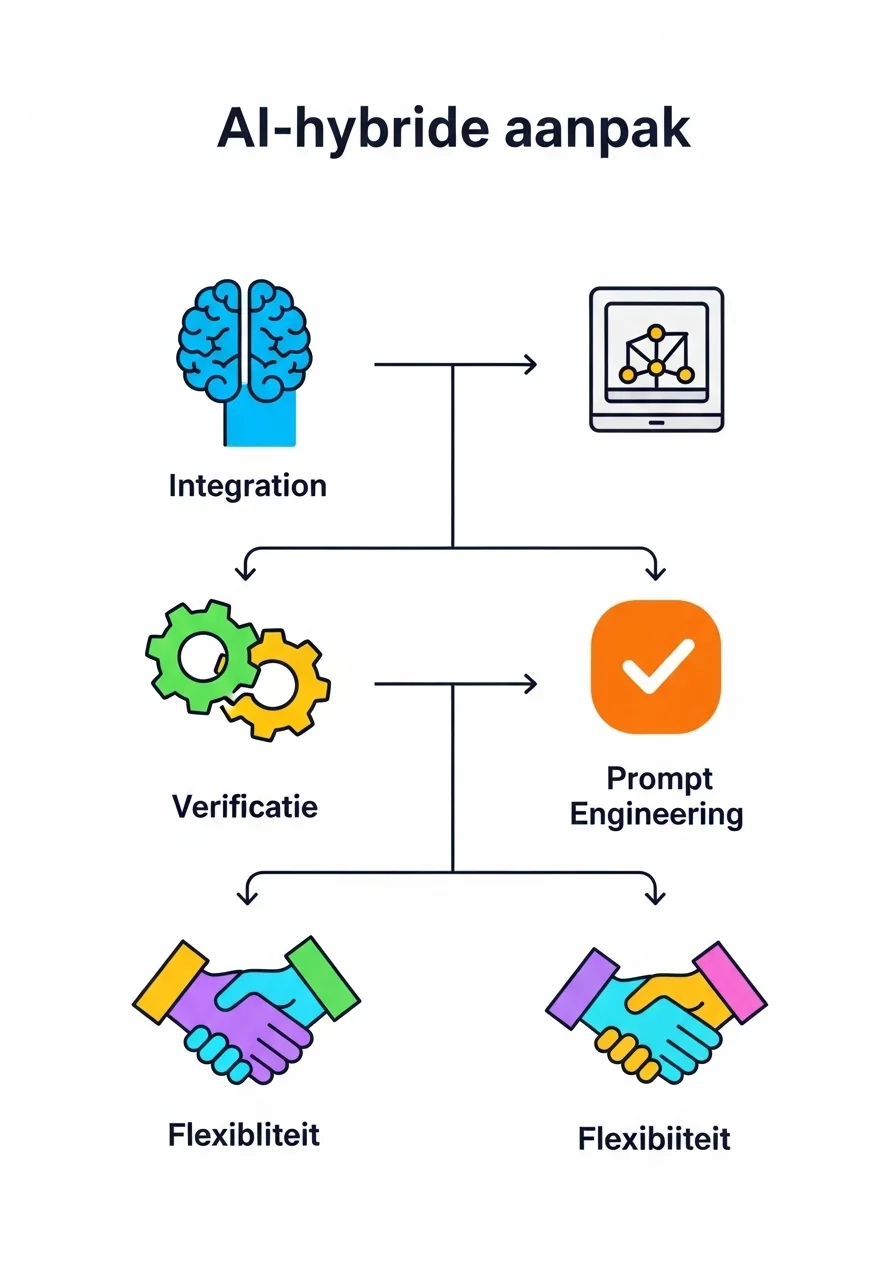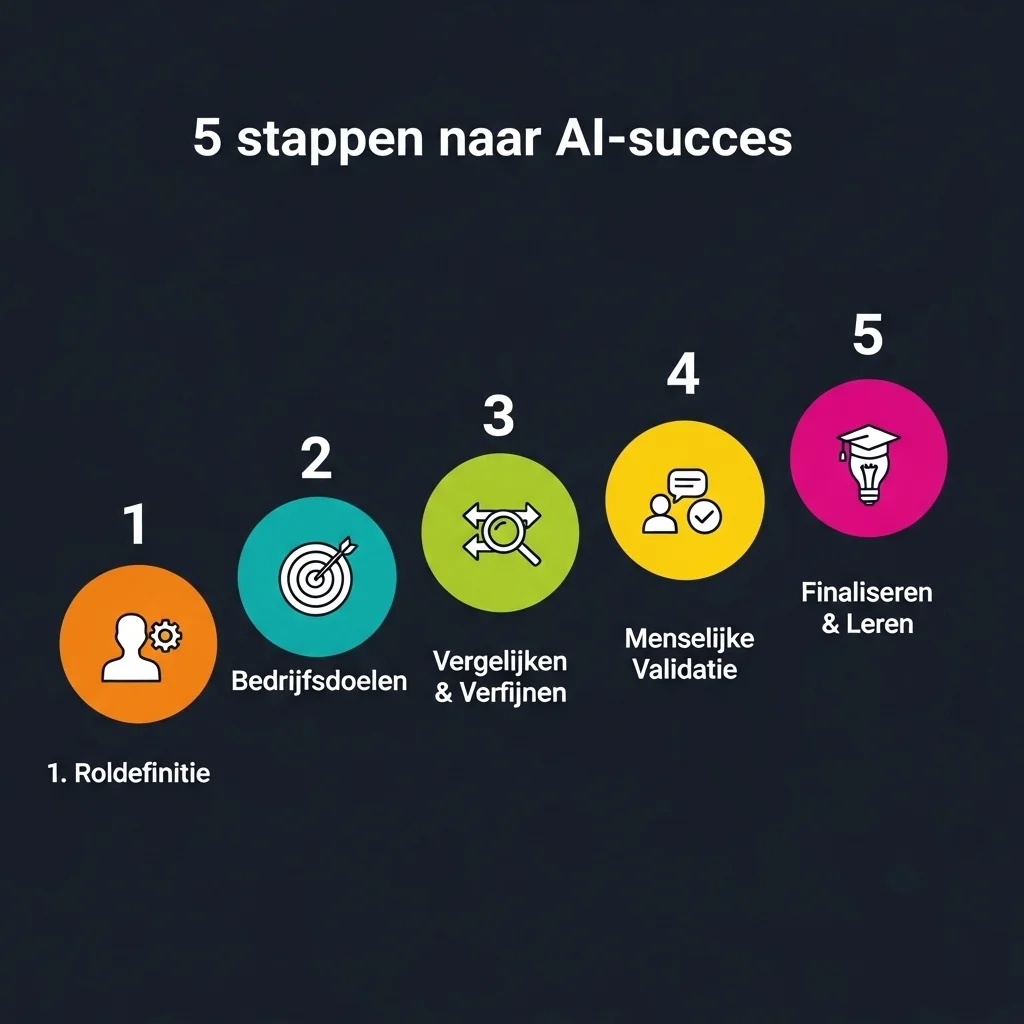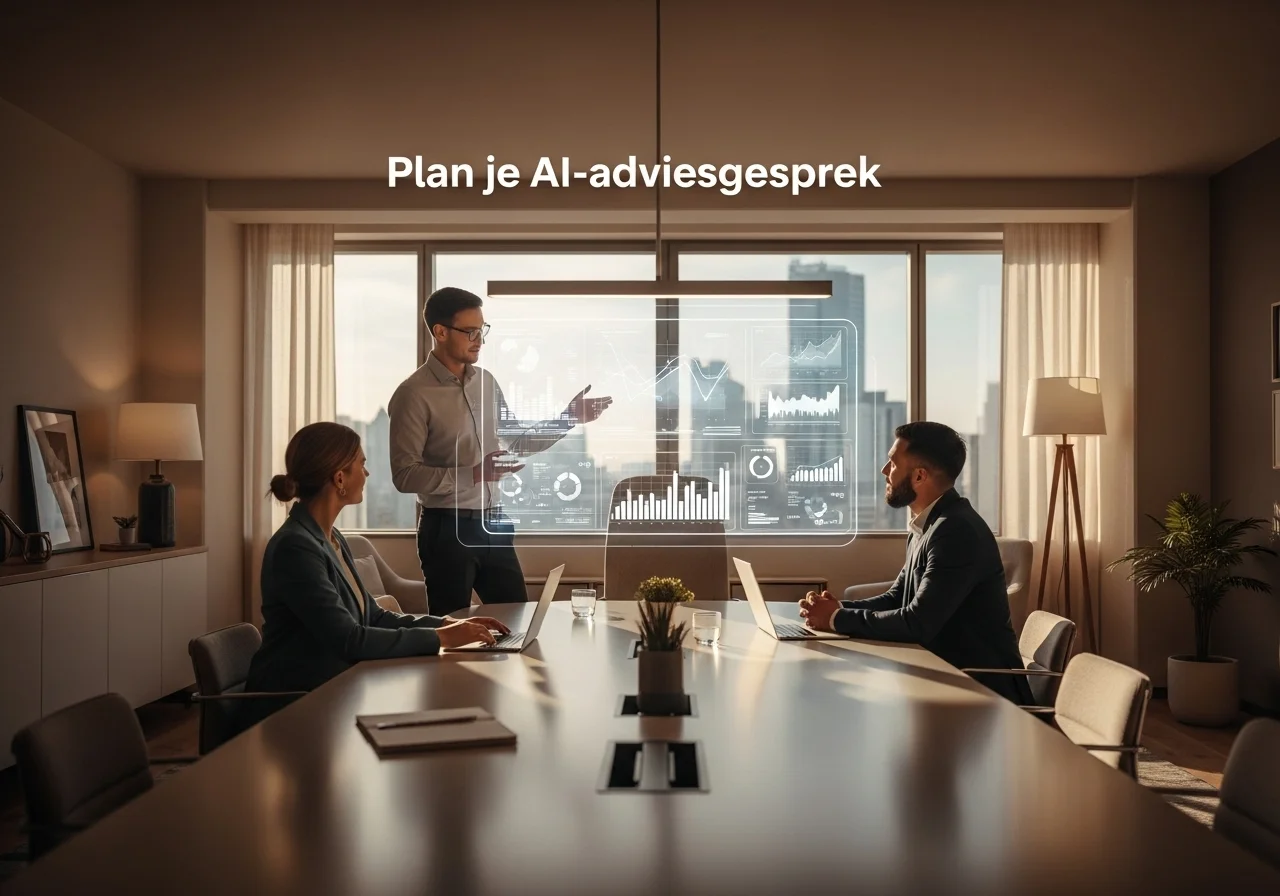AI as Co-Pilot: The New Reality for Professionals?
Have you ever wondered how artificial intelligence is going to change the way we work? This is no longer science fiction. Discover why AI is increasingly playing a crucial role in our day-to-day processes, and why human expertise remains absolutely essential in this exciting era.
AI, people and innovation: an unbeatable combination
Efficiency through AI?
A look at the hybrid approach.
The rise of advanced AI models such as ChatGPT, Claude and Gemini is changing the playing field. But how do we integrate these tools smartly into our professional workflows?
Fast Start
AI can generate initial concepts, drafts and answers incredibly quickly. It saves us hours of groundwork, whether you’re drafting a legal memo, writing marketing copy or sketching the first outline of a software architecture. The days of endlessly hunting for basic information are over.
Human Oversight
This is where the magic of human expertise comes in. AI is a brilliant co-pilot, but not an autonomous captain. Experts verify the AI output, add nuance, correct errors and provide the indispensable human touch. This is where real value is created.
Cost Savings
Imagine no longer burning countless billable hours on repetitive tasks or looking up basic information. By letting AI do the groundwork, professionals can focus on the complex, value-adding aspects of their job. That means money saved, especially for start-ups.
Working Smarter
It’s not just about speed or cost. It’s about smarter workflows. By deploying AI to generate first drafts or structure your thoughts, we can direct our energy towards strategic decisions, creative solutions and the human interaction that makes our work so unique.
What strikes me in practice is that the debate around AI often polarises: either it will take over everything, or it’s nothing but hype. The reality, certainly in software development and beyond, is far more nuanced. We’re seeing a shift where AI increasingly acts as an intelligent assistant, an amplifier of human capabilities. That doesn’t mean it fully takes over our tasks, but it can make our workflows drastically more efficient—provided it’s used and checked properly. It’s a symbiosis between human and machine.
The AI hybrid approach: more than just theory.
Practical insights for your organisation.
The crux lies in integration. How do you make sure AI helps you without taking control?
Clearly define the AI role: Where can AI do the groundwork? Where do you need human validation?
Implement robust verification processes: Make sure there is always an expert who critically reviews the AI output.
Invest in prompt engineering: The quality of the output stands or falls with the quality of your input. Learning how to ask an AI the right questions is a new core competency.
Keep learning and adapting: The AI world evolves at lightning speed. What works today may be outdated tomorrow. Flexibility is crucial.

Your blueprint: deploying AI intelligently in five steps
So how do you tackle this in your own processes? Whether you’re a developer, an entrepreneur or a professional in another sector, these steps will set you on the path to an effective hybrid workflow:
Define the AI's role
Before you start, assign the AI a specific role and area of expertise. Imagine this: You are the most capable software architect with expertise in cloud-native solutions and scalable microservices. This gives the AI the right context and focus for its answers. The quality of your instructions directly determines the quality of the output. Pro tip from us: be as specific as possible about the knowledge and experience you expect from the AI.
Formulate your business goals and specific questions
Draft a detailed memo to the AI about your business goals. What do you want to achieve? What challenges are ahead? Finish with a list of specific questions you want answered—and don’t forget that essential safety-net question: Is there something I’ve overlooked? Ask the AI for citations, for instance to code samples, architecture patterns or relevant documentation. This makes the answers more concrete and easier to verify.
Compare and refine
Run your prompt through different AI models—we use various tools in-house depending on the task. Collect the answers in a spreadsheet, for example, with the questions as rows and the AI answers as columns. This gives you a quick overview of the state of play and any inconsistencies. Spot new concepts or terms? Dive into them! Adjust your original memo if necessary based on these initial insights and repeat the step for an even better result.
Validate with a human expert
Armed with a detailed concept plan and perhaps even the first rough drafts of documents or code, it’s time for the human expert. Present the same memo and questions to the specialist. Compare their answers with the AI's. If the expert confirms the AI’s answers, brilliant—you know the AI has set you on the right track. If not, that’s even more valuable: the expert has identified a crucial gap or error, and thereby delivered immediate added value.
Finalise and learn
The final step is finalisation, preferably by the human expert, potentially building on the AI-supported drafts. This process of constant feedback and comparison not only leads to a better end product, but also to a deeper understanding of the subject matter. You learn how to deploy AI more effectively and where the limits lie. For us as a software development team, this means we can innovate faster while still guaranteeing the highest quality.

The AI revolution: co-pilot or replacement?
A new era for professional services.
The discussion about AI is heating up. Everywhere you read how AI will take over jobs, upend sectors and transform the world as we know it. Yet from our experience it is far subtler. AI is not a replacement—at least not yet—but a powerful co-pilot. Take Balaji’s example of using lawyers as AI verifiers. It may sound futuristic, but it’s brilliantly simple. It’s the essence of the hybrid approach: use AI for speed and scale, and humans for depth, nuance and validation.
An interesting development I see is that AI forces us to reassess where real value lies in professional services. If an AI can generate the basics in a fraction of a second, where does the added value of the human professional lie? The answer is clear: critical thinking, solving complex non-standard problems, empathy, strategic insight and the creativity to think outside the box. These are qualities AI does not yet possess and that are crucial for any successful project—certainly in custom software development.
What I notice in practice is that the best results come when we see AI as an extension of our capabilities, not a replacement. Take code generation: tools like GitHub Copilot are fantastic for boilerplate code or suggesting functionality. But architecting a complex system, weighing up different technologies based on years of experience, or grasping intricate business logic? That remains the domain of the seasoned developer. AI helps us get to the heart of the matter faster so we have more time for the real thinking.
Recently we’ve seen AI tools become ever better at analysing large datasets and identifying patterns. This is invaluable for detecting security leaks or optimising performance in existing software. Yet it’s the human expert who interprets the findings, weighs the risks and makes the final decision on implementing a solution. The balance between automation and human intelligence is the key to success in digital transformation.
Human expertise: the irreplaceable factor in software development.
Why Spartner believes in the hybrid model.
As a software development team we see AI’s potential every day. From writing tests to debugging code, AI can significantly increase development speed. But the core of our work remains human creativity and problem-solving ability. At Spartner we strongly believe in the hybrid model: AI as a powerful tool and the human expert as the orchestra’s conductor.
Think about designing a complex application. AI can suggest database structures or API endpoints. But does AI understand the subtle nuances of your business processes? The unspoken needs of your users? The strategic course for the next five years? Probably not. That’s where the human factor is indispensable. Our experienced software developers and architects bring not only technical knowledge but also deep insight into the business and the market. They translate a vision into a deliverable product.
Our experience shows that the most successful projects are those where humans and AI complement each other. A handy trick we often use is asking AI to generate multiple solution directions for a problem. Our developers then critically assess these options, weigh the pros and cons and select the most suitable approach—often with their own refinements. This speeds up the innovation process enormously without sacrificing quality or originality.
The latest trend shows a growing demand for AI-augmented development, where developers use AI tools to be more productive, not to work less. The idea is that we developers free up more time for creative and strategic work instead of being stuck in repetitive tasks. This is where Spartner’s expertise comes in: we not only implement the latest technologies but also advise on how to leverage them optimally within your existing team and processes. It’s an exciting time to be a developer—a time in which our focus shifts from pure execution to more strategic and innovative work.
Frequently asked questions about AI and software development
Naturally, a fast-evolving topic like AI raises many questions. Here we answer a few common ones from our perspective as an experienced software development team:
Can AI take over my entire software project?
No, at present and for the foreseeable future that’s unlikely. AI can excel at specific tasks such as code generation, writing tests or debugging. It can even propose an initial architecture. But the complexity of a full software project—including understanding intricate business logic, managing stakeholders, making strategic decisions and implementing unique, creative solutions—demands human expertise and insight. AI is a powerful co-pilot, not a self-steering captain.
How does AI save time and money in development?
AI saves time by automating repetitive and labour-intensive tasks. Think generating boilerplate code, writing documentation or performing basic analyses. Developers can then focus on the more complex and valuable aspects of their work. This greatly accelerates the development process and reduces the billable hours needed for standard tasks, ultimately leading to cost savings—especially on larger projects.
What role does prompt engineering play with AI tools?
Prompt engineering is crucial. It’s the art and science of formulating the right questions and instructions to an AI model to get the desired output. Ask an AI to write code and you’ll get something very different from asking for a scalable and secure Laravel application architecture for an e-commerce platform with external payment gateway integration. The quality of the output stands or falls with the precision and clarity of your input. It’s a skill every professional working with AI should develop.
Is this only for large companies?
Absolutely not! The beauty of many AI tools is their accessibility. Large enterprises, start-ups and SMEs alike can benefit from AI. In fact, for smaller businesses AI can be a game-changer because it enables them to work faster and more efficiently with limited resources. It democratises access to advanced tools and allows start-ups to compete with established names through smart use of technology.
How does Spartner stay ahead with AI?
At Spartner we embrace innovation. We continually experiment with the latest AI tools and techniques, from code assistants to AI-driven test automation. We invest in team training so our developers are not only experts in Laravel and other frameworks, but also in effectively integrating AI into their daily workflow. Our approach is always pragmatic: we implement AI where it truly adds value and makes our projects stronger and more efficient, while keeping human control and creativity central.
Are there risks with AI verification?
Yes. One of the biggest risks is AI hallucination, where the AI generates convincing but factually incorrect information. That’s why human verification is so crucial. Another risk is bias in the training data, which can lead to prejudiced or unethical outputs. And of course there are privacy and security considerations, especially when entering sensitive information into public AI models. It’s essential to understand these risks and implement mitigation strategies, such as using private models or strict internal protocols.

Curious how AI can accelerate your specific project or organisation without compromising on quality or human control? Or would you simply like to brainstorm about the future of software development and AI’s role in it? I’d love to hear your thoughts! Let’s talk—feel free to get in touch for a no-strings-attached consultation. Your insights are valuable!
